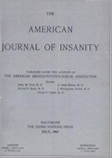SET IN THE SCHIZOPHRENIC AS MEASURED BY A COMPOSITE REACTION TIME INDEX
Abstract
Twenty-five schizophrenic patients and 10 normal subjects were used in an experiment on reaction time employing preparatory intervals of 1, 2, 4, 7.5, 15 and 25 seconds in length. Two procedures were used. In the regular warning procedure each particular interval was presented a number of times in succession. In the irregular warning procedure the various preparatory intervals were presented in a systematically random fashion. The principal findings were:
1. Normals showed significantly shorter reaction times than did the patients, although there was a small degree of overlap. The shortest reaction times of the normals occurred at the 2-second interval in both procedures. The patients on the other hand showed their minimum times with somewhat longer intervals.
2. In the normal subjects the reaction times of the regular procedure are significantly shorter than those of the irregular procedure at each interval except the 25-second, at which point the two curves crossed. The differences between the two procedures diminished with increase in length of interval. The schizophrenics gave shorter times in the regular procedure at only the 1-, 2-and 4-second intervals. At the longer intervals, the times of the regular procedure were actually longer than those of the irregular procedure.
3. A composite index was constructed on the basis of these differences between patients and normals, which effectively separated the two groups with practically no overlap. This composite index, which can be expressed in terms of a single number, is more effective in differentiating the two groups than is simple reaction time level.
4. The suggestion is made that such an index has practical value as a clinical device.
Access content
To read the fulltext, please use one of the options below to sign in or purchase access.- Personal login
- Institutional Login
- Sign in via OpenAthens
- Register for access
-
Please login/register if you wish to pair your device and check access availability.
Not a subscriber?
PsychiatryOnline subscription options offer access to the DSM-5 library, books, journals, CME, and patient resources. This all-in-one virtual library provides psychiatrists and mental health professionals with key resources for diagnosis, treatment, research, and professional development.
Need more help? PsychiatryOnline Customer Service may be reached by emailing [email protected] or by calling 800-368-5777 (in the U.S.) or 703-907-7322 (outside the U.S.).



